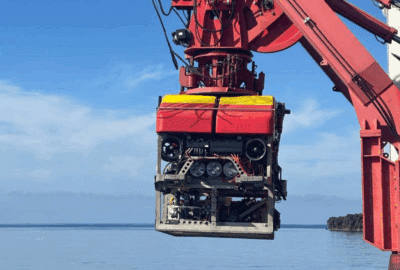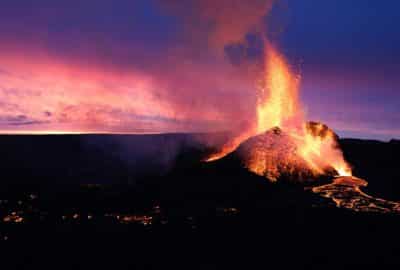How were new craters on Mars discovered?
Wednesday 16th Nov 2022, 12.30pm
When a space rock smashes into the surface of a planet, a hole – or crater – is formed. New craters might be relatively straightforward to identify on Earth, but what about on other planets, such as Mars? In this episode we hear from Dr Ben Fernando, a researcher from Oxford’s Department of Physics and a scientist on NASA’s InSight mission, about the techniques used to discover new craters on the Red Planet.
(Music)
Emily Elias: Mars is moving and shaking, or at least that’s what Oxford researchers have been tracking for the past few years. But little did they know what exactly they were going to learn by putting a seismometer on the surface of the red planet.
On this episode of the Oxford Sparks Big Questions podcast, we are asking how were new craters on Mars discovered?
(Music)
Hello, I’m Emily Elias, and this is the show where we seek out the brightest minds at the University of Oxford and we ask them the big questions. And for this one, we found a researcher whose email inbox is full of wonder and amazement.
Ben Fernando: So, I’m Ben Fernando. I’m a physicist working on one of the NASA Mars missions called ‘Insight’ here at the University of Oxford.
Emily: And in the vein [of] there’s no such thing as a stupid question. We’re talking about craters today. What is a crater?
Ben: No, it’s actually a really good question. So a crater in this context is a hole in the ground, basically, that forms when something smacks into the surface, going pretty fast. So the craters that I study are on Mars and they’re formed by meteoroids.
That is bits of space rock falling into the atmosphere and then smacking into the surface and they leave behind holes. And obviously the bigger the piece of stuff that falls in, the bigger the crater is at the end of it.
Emily: And it’s that smacking motion that you are particularly interested in because you were part of a crazy project that put a seismometer on the surface of Mars.
Ben: Yeah, exactly. So when an earthquake happens on Earth, it generates seismic waves and that’s what you feel when you feel an earthquake and what your seismometer would record. On Mars, we have Mars-quakes, but what we also have are these impact events. So Mars doesn’t have much of an atmosphere. There are a lot more things that hit the surface and those rocks hitting the surface generate seismic waves, which we can detect exactly the same way that we detect Mars-quakes.
And if you are on Earth, it’d be exactly the same way you detected earthquakes.
Emily: That is the link between a crater and a seismometer?
Ben: Exactly. Yeah. So a crater makes hole, hole makes waves. We detect the waves.
Emily: So what were you doing then last Christmas?
Ben: So last Christmas, I was trying to take some time off, which is sometimes a difficult thing to do as a scientist.
I got this email that said, ‘Oh, there’s been a really big Mars-quake on Mars’. And I was like, okay, could Mars not have just waited a couple of days because we’re all on holiday? But read the email and thought nothing more of it.
Emily: But little did you know….
Ben: Little did I know, a couple of weeks later, someone had been looking at the weather satellite data.
So we have what’s effectively a weather satellite orbiting Mars that takes images of the surface very regularly so we can look at things like the dust in the atmosphere. And we had a rough idea of where this Mars-quake had come from and they looked in the same place and all of a sudden there was a massive black splodge on the surface. Pretty big. I think we’re talking probably 20, 30 kilometres across. So something that was very obvious when you weren’t even looking for it.
Emily: And you had never noticed this black splodge before? This was a new black splodge?
Ben: Exactly. So the crater formed sometime very early on the morning of Christmas Day/late on the night of Christmas Eve, depending on which time zone you were in.
And this black splodge had basically formed at exactly the same time, very close to where we thought the Mars-quake had occurred.
Now you see black splodges from time to time and they might be dust deposits or rocks falling or something. But this one, it was a bit odd that it just so happened to coincide with the Mars-quake.
Now we couldn’t see a crater at that point. It wasn’t good enough resolution, but it was clear that something could happen in that area very recently and very close to when we’d seen this big Mars-quake.
Emily: So what did you guys do?
Ben: So the imaging team on the Mars reconnaissance orbiter, so this is the satellite that’s taking the pictures, used a higher resolution camera.
So once they had some idea where to look, they used the higher resolution camera to take an image of this black splodge. And surely enough, at the centre of this black splodge, there was an absolutely enormous crater.
Emily: Now this crater, aside from its shape that you were able to monitor and going through the data and figuring out the seismic impact of it, what else did it reveal? What other little sneaky bits about Mars did we learn from it?
Ben: So the first thing to bear in mind is that at the time, this was the biggest fresh crater we’d ever seen form anywhere in the solar system ever. So there are bigger craters, but they’re all old. We’ve never seen them happen. This was absolutely enormous.
It was, sort of, a 120, 130 metres across, our first estimate was, and in that picture, it looked reasonably circular, but there were a couple of white splodges at the bottom, and it wasn’t immediately obvious what they were. We didn’t have a good enough resolution at that time to see, but it was intriguing because this creator was so big and so deep, and there was clearly something else at the bottom of it.
Emily: So what was at the bottom?
Ben: So it took a little while to answer that question because we needed to get an even higher resolution image of the crater, and that takes time to do. So then you’re getting around to, sort of, talking meter to submeter per pixels. So really, really cool. What we saw down there actually was ice.
So this hole was so deep that it actually excavated ice beneath the sand.
Emily: Like, water ice?
Ben: Water ice. Exactly.
Emily: But what does that then tell you about Mars?
Ben: So it was really exciting. So there is water ice on Mars, especially at the poles. It tends to be below the surface just because all the ice on the surface has sublimated away.
And we’d seen water ice in craters before. But the weird thing was this crater was actually pretty close to the equator, so it would be probably semi-tropical is the equivalent if it was on Earth and we really weren’t expecting to see ice that close to the surface that far south.
Emily: I mean, does that make your scientist heart and brain go crazy of trying to marry the emotions of everything that you’re seeing with the logic of, “How does this make sense?”
Ben: Yeah, it’s pretty cool. I think everyone who works on Mars has a bit of an attachment to water or to ice in particular, because at least on Earth, everywhere that we find life, we also find water. And most places you find water, you also find life.
So certainly this isn’t liquid water. It won’t stay stable on the surface for very long. It’ll sublimate and evaporate away. But it was still pretty cool to find this ice that no one had expected to see. And some of the imaging folks have been writing papers on it, and it’s pretty cool because maybe it means there’s more ice on Mars than we previously thought.
Emily: But as you were looking at all your splodges, I understand that you also noticed something that looked a little bit like your Christmas crater, but was slightly different?
Ben: Yeah, so I think it was very much the case of once you’ve seen one and you’ve got your eye in for it, some of the folks were looking back at the other Mars-quakes that we’ve recorded and, sort of, in the springtime they went back and said, “Hey, you know, there was one that we thought looked kind of interesting back in September, but we just moved on from it and put it as another one of the many interesting Mars-quakes that we’ve had.”
And then the imaging folks came back to us in the springtime and we had a very long meeting about this particular, the first crater. And at the end of it they went, “Oh, and by the way, we found a really big black splodge. That’s in fact, the crater is even bigger associated with this big event that we saw back in September and have all moved on from.”
So then all of a sudden we’d had not just one enormous crater form, but a second one. And the one that had formed in September, i.e. before the Christmas one, was actually slightly bigger. We just hadn’t noticed the crater itself because the black splodge wasn’t so big, but the crater itself was actually larger.
Emily: Now with that second crater, did you find similar things with ice and water as you did with the Christmassy crater?
Ben: So this crater was, kind of, different. One of the most noticeable things from it was the blast pattern. So, as you can imagine, this meteoroid strikes the surface, it’s going several times the speed of sound, and it creates a blast pattern, just like a gunshot would on Earth, if it hit a plain, white wall or something, you would see a blast pattern around it. This one, the blast pattern was particularly interesting and we could actually use it to tell something about the trajectory and the dynamics of what happened when the meteoroid hit the surface.
So we had two creators, which in some ways were very similar, but in other ways quite different. You know, they clearly showed different information in the blast pattern. One had this ice really far south, which was pretty cool. But we were then wondering, you know, we maybe thought that we would see something like this every few years. And then all of a sudden we’d seen two within the space of ninety days. So that was pretty weird as well.
Emily: Is there any way to say that they were linked to a same event?
Ben: It’s difficult to say in some sense. So they happened 90 days apart, which is perhaps closer than we would’ve expected but, equally, it’s hard to imagine what it might have been that would’ve produced two signals, 90 days apart.
So if Mars had run into an asteroid, well, 90 days later, Mars has moved, you know, millions of miles in its orbit, so it’s unlikely to run into another piece of the same asteroid. We’ve thought about whether something was in Mars’ orbit and breaking up, and so bits were falling out of the atmosphere over time just due to the drag.
But it’s really difficult to say. There’s, kind of, two options. One is that it’s just random chance and they just so happen to be close together, but it’s still, kind of, weird that two of them happened in 90 days when we hadn’t seen any previously in the couple of years that the mission had been going.
The other possibility is, of course, that they are linked, and I think we’re all trying very hard to think of what would be compatible with the facts.
Would it be that, you know, as I said, something had been orbiting Mars, broken up and then bits are now falling into the atmosphere or, you know, was it something else entirely? With only two, it’s very difficult to tell the difference between them though of course it does raise the question, were there more than two and we’ve only just noticed two so far, given that one happened several months previously and we had, sort of, noticed it and then moved on without quite realising how significant an event it was?
Emily: Are you guys still looking for more black splodges then?
Ben: Yeah, we are. So Insight’s in a bit of a sticky situation. It’s, kind of, losing power. The seismometer is only on about half the time these days, but the satellites are still in orbit and they’re still taking pictures of the surface frequently.
And we haven’t recorded any Mars-quakes recently, just because we’re in a really noisy part of the Martian year. But if we were to record a Mars-quake, we would be looking for something in the images. And similarly, if we were to take an image and see a splodge or a new crater, we would be going backwards and trying to find something in the signal to match up to it.
Emily: So is that the next, sort of, step that you guys are looking for more stuff?
Ben: Yeah. So as we come towards the end of the mission, we’re starting to think a little bit more about the statistics of how creators form over the few years that we’ve been there. We know something about how often we see new craters and images from orbit because we’ve been taking pictures of the surface of Mars for years, but we haven’t been listening for them, seismically, for very long.
So it’s, sort of, a chance to try and marry up those two bits of the puzzle, if you like. And, of course, even after the end of the mission, there’ll still be work to do in terms of going back and analysing the old signals that we’ve seen of, for example, smaller craters to try and, if you like, maybe even bridge the gap between the small craters, which we see a few of, and these two absolutely enormous craters, which we weren’t really expecting to see.
Emily: Still pretty cool.
Ben: Yeah, very cool. A nice surprise.
(Music)
Emily: This podcast was brought to you by Oxford Sparks from the University of Oxford with music by John Lyons, and a very special thank you to Ben Fernando.
If you’ve got a big question, hit us up. We are on social media @OxfordSparks, plus we’ve got a website, can you believe it? Oxfordsparks.ox.ac.uk.
I’m Emily Elias, bye for now.
(Music)
Transcribed by UK Transcription.





